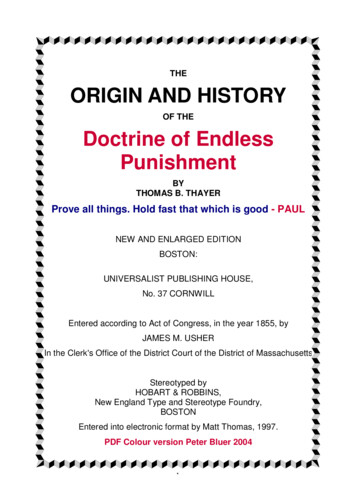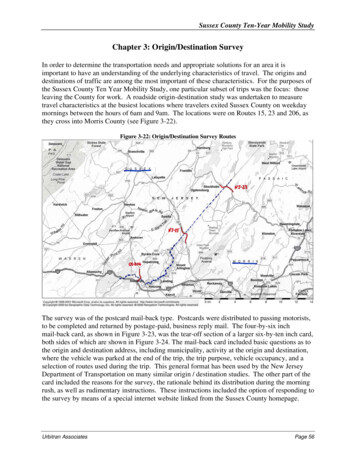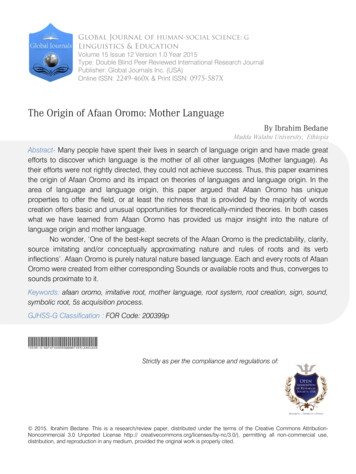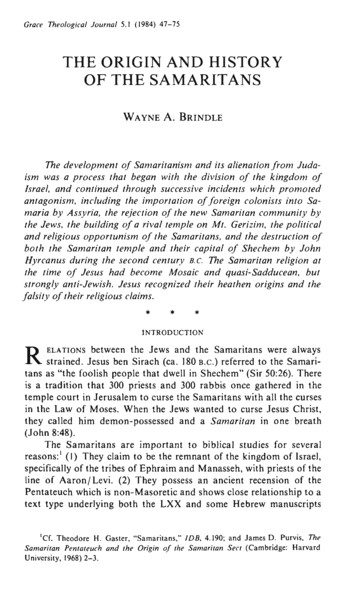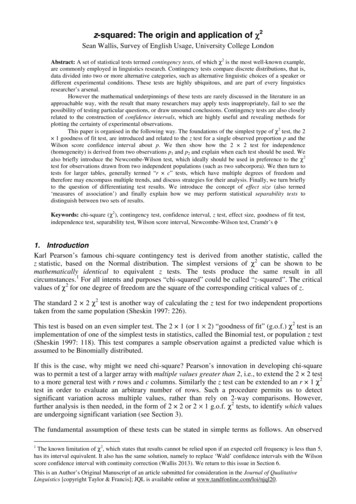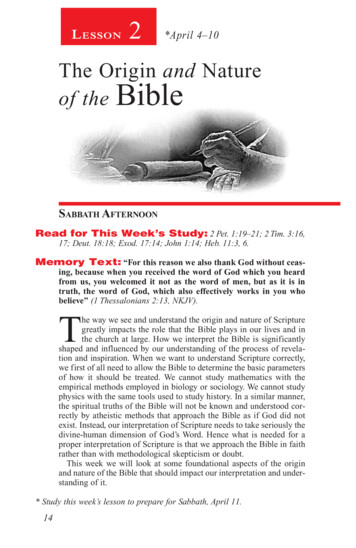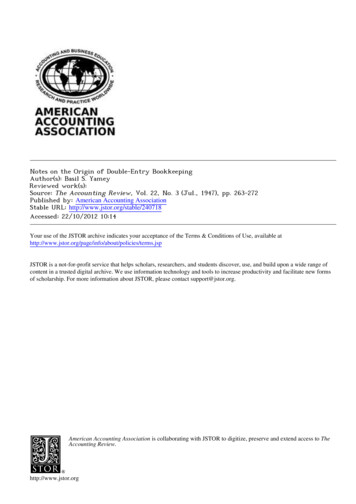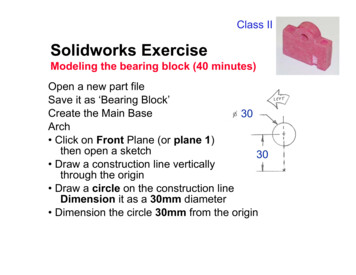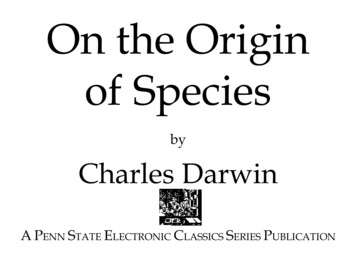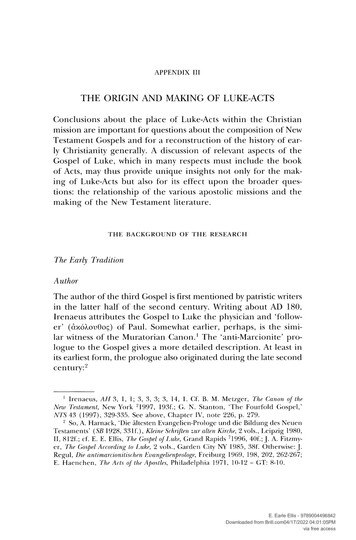
Transcription
APPENDIX IllTHE ORIGIN AND MAKING OF LUKE-ACTSConclusions about the place of Luke-Acts within the Christianmission are important for questions about the composition of NewTestament Gospels and for a reconstruction of the history of early Christianity generally. A discussion of relevant aspects of theGospel of Luke, which in many respects must include the bookof Acts, may thus provide unique insights not only for the making of Luke-Acts but also for its effect upon the broader questions: the relationship of the various apostolic missions and themaking of the New Testament literature .THE BACKGROUND OF THE RESEARCHThe Early TraditionAuthorThe author of the third Gospel is first mentioned by patristic writersin the latter half of the second century. Writing about AD 180,Irenaeus attributes the Gospel to Luke the physician and 'follower' ( ax6A.ou8oc:;) of Paul. Somewhat earlier, perhaps, is the similar witness of the Muratorian Canon.' The 'anti-Marcionite' prologue to the Gospel gives a more detailed description . At least inits earliest form, the prologue also originated during the late secondcentury: 21Ire naeus , AH 3, l, l ; 3, 3, 3; 3, 14 , l. Cf. B. M. Me tzger, The Canon of thel93f.; G. N. Stanton, 'The Fourfold Gospel,'New Testament, New York 1997,N"J:S 43 (1997) , 329-335. See above, Chapter IV, note 226, p. 279. So, A. Ha rnack, 'Die altesten Evangelien-Prologe und die Bildung des NeuenTestaments ' (SB 1928, 331 f.), Kleine Schriflen zur alttm Kirche, 2 vols., Leipzig 1980 ,II , 8121.; cf. E. E. Ellis, The Gospel of Luke, Grand Rapids 7 1996, 40f.; .J. A. Fitzmye r, The Gospel According to LukP, 2 vuls., Garden City NY l98:l , :18f. Otherwise: .J.Regul, Die antimarcionitischen t'vrmgelienprologe, Freiburg 1969, 198 , 202, 262-267;E. Hae nchen, ThP Arts of the AjJostles, Phil ad e lphia 1971 , 10-12 GT: 8-10.E. Earle Ellis - 9789004496842Downloaded from Brill.com04/17/2022 04:01:05PMvia free access
378APPENDICESLuke is a man from Antioch, Syria, a physician by profession. Hewas a disciple of the apostles, and later he accompani e d Paul untilhis martyrdom. Having neither wife nor child he served the Lordwithout distraction. He fell asleep in Boeotia at the age of eighty-four,full of the Holy Spirit. . Moved by the Holy Spirit, Luke composedall of this Gospel in the districts around Achaia.The 'Gospel' of the heretical Marcion, dating from about 144,also indirectly supports Lukan authorship. As reconstructed fromquotations and detailed references in Tertullian and Epiphanius,it represents an abbreviated form of Luke, an abbreviation thatIrenaeus and Tertullian attributed to a deliberate mutilation byMarcion. 4 Although Marcion ascribed no author to his Gospel,he is known to have accepted only Paul as a true apostle. Thissuggests that he associated Luke's Gospel with a companion ofthe Apostle and, as Harnack concluded," abridged it in order to'purify' it from Luke's Judaistic corruptions. According to ananonymous appendix (by Zephyrinus?) to Tertullian's Prescriptionagainst Heretics this truncated Luke was introduced by Marcion'steacher, Cerdo. 6TilleThe title 'Gospel according to Luke' appears in the earliest manuscripts of the Gospel, for example, in the Bodmer papyrus (p75)from the early third century. It was created when a church wishedto distinguish Luke from other known Gospels and, since similartitles appear (imitatively?) on the Gnostic Gospels 'accordingto' (xma) Philip and Thomas , it goes back at least to the middleof the second century. More importantly, the collective use ofn1ayy A.tov, which is common in the New Testament and the Apostolic Fathers, dies out after the mid-second century. Probablythe title, EuayyEALOV xma Aouxdv, dates from c. AD 100. 7:' So, A. von Harnack , Marrion , Durham NC 1990 , 17 GT: 26 , *2!J .TheEnglish edition lacks the appendices.1Irenaeus , AH . 12 , 12; Tertullian , Against Manion 4:2.·, Harnack (note ). *2!J .,; Tertullian, de fmtrs. harr. !) I Appendix, 6. Cf. ANF Ill, 65 .7So , B. Re icke, The Roots of lhr SynofJlir GosjJPls, Philadelphia 1986 , 150-155;cf. M. Hengel , Sturlirs in tltr Gospel ofMrak, London 198!) , 8 f.:The titles of theGospels probably 'can be traced hack to the time of the origin of the four Gospels be tween 69 and I 00 and are connected with their cir c ulation in the communi tv' (R4). Otherwise: H. Koeste r, Anriml Christian GosjJPls , Philadelphia 1990,24- I; P. Vielhauer, Grsrhirht r drr urrhristlirhrn Litrmlur , Berlin 197!) , 2!J2-2 :iH.E. Earle Ellis - 9789004496842Downloaded from Brill.com04/17/2022 04:01:05PMvia free access
APPENDIX III379The name of Luke, however, was probably attached to the Gospel at the beginning. In the ancient Orient a book was identifiedby title. '[T]he most significant contribution which the Greeksmade to [book] cataloging was the use of the author of a workfor its entry.' If the titulus was lacking, the roll would be taggedwith the name of the author when it was placed in a library, for'after going to the general subject . [the reader] was accustomed to look next for the author-title was secondary. H 'Privatelibraries had become as common as baths in the houses of therich' (Hadas), and a copy of Luke's volumes, properly tagged,was in all likelihood placed in the library of his patron, Theophilus.'lAuthorityThe authority of the Gospel, that is, the recognition of its canonical status in (many areas of) the church, is explicitly documented from the time of Irenaeus. Indirectly, it may be traced back tothe first half of the second century:1. As was suggested above, Luke's work was used by Marcion(or his teacher Cerda) in constructing his own 'Gospel.'2. Before 140 it was probably cited as Scripture in II Clem 13:4( 'says God') IO and, a little later, alluded to by the apocryphal (Gnostic) Gospel of Truth (33:15) , Gospel of Philip(126:7ff.) and Gospel of Thomas (65-66) II Ruth F. Strout. 'T he Deve lopment of the Catalog and Cataloging Code s,'TltP ! J brmy QuartPrly 26 (1956) , 254-2 75, 257.'' Cf. M. Hadas, A nrilla to Classiml Rmding, New York 1954, 2.'i. Cf. Seneca, riPtranquil. rmimi 9,4ff.; Suetonius, riP illus. gram. 6; Aurelius, ad Frontonem 4,5; Ellis(note 2), 64f. Similar, M. H e nge l (note 7) , 17 4 n. 70 GT: Die l ·.'vangelim Ub!"r srhriftm, He idelberg 1984 , :1111.; M. Dibelius , Stud iPs in the Arts of the ApostiRs, London1956 , 135 ff. GTL I !Sf. Otherwise: F. Bovon, Das l :'vangelium nru1t Lukas I, Neukirch e n 1989 , 24. On the dedication of a book to a patron cf. Jos e phus, Antiquities I, Sf. ; F. F. Bruce, The Arts of the AjJOstlPs, Le ic e ste r UK: 1990 , 98. See below,note 104.10Pam K. P. Don fried, ThP Setting of SrYonrl Clement in Farl y Christianity, Le i den1974, who dat es II Clement to c. AD 100 (1), 'closer to Paul than tojustin'(80), and suggests a quotation from a hypo th et ical 'non-canonical source' (78).Howeve r, he recog nizes a possible dependence on Luk e at II Clem 6: I (79).But see Metzg e r (note 1) , 68-72.11 Cf. C. Tuckett , Nag Hamrnadi and the Gosf!el Tradition, Edinburgh 1986 ,149-Hi:l; K. Grobe!, The Gosf!el of Truth, Nashville 1960 , 143; K. R. Snodgrass,'The Parable of the Wi c ked Husbandm e n: Is th e Gospel of Thomas Version theOriginal'' NT ; 21 (1975), 142ff.; E. E. Ellis, P1ophPry and Hermmeutir in l 'a rlyE. Earle Ellis - 9789004496842Downloaded from Brill.com04/17/2022 04:01:05PMvia free access
380APPENDICES3. About mid-century Justin Martyr very likely used Luke'sGospel or a harmony based upon it. 124. Valentinus (fl. c. AD 136-165) derived his chronology fromit; 13 his disciple Heracleon apparently wrote a commentaryon it, and Ptolemaeus cited it as (canonical) authority. 14Each of these witnesses illuminates the background for the inclusion of Luke in the 'fourfold' Gospel that was affirmed by latesecond-century Christianity.Apparently the status accorded to the Gospel of Luke withinthis fourfold canon had two grounds, the association of Luke withPaul's apostolic authority and with his mission and the conviction that Luke himself was a prophet. Irenaeus and Tertullian and1perhaps even Justin Martyr point to Luke's relation to Paul. However, like the Muratorian Canon and the prologue mentionedabove, Origen includes Luke among Evangelists who 'wrote fromthe Holy Spirit.' 11i Such references suggest that Luke's credentialsdid not rest solely on his association with the Apostle. His lateridentification with the prophet Lucius of Cyrene (Acts 13:1) andthe attention given to Christian prophecy in Luke-Acts point inthe same direction. Although not a certainty, there is a reasonable probability that Luke's writings were from the first receivedand valued as the work of a prophetic personality. 17The Fourfold GospelThe 'fourfold' Gospel was, well before the close of the secondcentury, an established tradition in large segments of the churchin Gaul, North Africa, Egypt, Rome and perhaps Syria. Thus Irenaeus writes,J. M. Robinson,'On Bridging the Gulf From Q to the Gospel of Thomas (or Vice Versa),' NagHammadi, Gnoslit:isrn and Early Chrislianily, e d. C. W. Hedrick, Peabody MA 1986,127-17!).12Cf. Justin, I Apol. 34:2; Dia l. 51 :3; 76:6 with Lk 2:2; 16: 16; I 0: 19; 2: 1-.'i; B.F. Westcott, Tlw Canon of lhl' Nnv Teslamenl , Cambridge 1881, I 00-173.1:' lrenacus, AH 2, 22, 4; Lk 3:23; cf. 4: 19; cf. J. B. Lightfoot, Bibliral &says,London 1904, 56f.14Clement, Strom. 4:9. B. Aland, 'Die Rezeption d e s neutestamentlichenT ex tcs,' T/u New '1/ slamPnl in / a rly Chrislianily, e d. J.M. Sevrin , l. e uven 1989,1:1-19.1'' .Justin, Dial. 10:1:8.Hi Origen, Homily on l : ukP OnP, Preface.17Cf. Ellis (note 2), :l7f.Chrislianily, Ti.Ibingcn and Grand Rapids '1 1993, 206. Otherwise:E. Earle Ellis - 9789004496842Downloaded from Brill.com04/17/2022 04:01:05PMvia free access
381APPENDIX III'The Word . gave to us the Gospel in a fourfold shape, but heldtogether by one Spirit. HClement of Alexandria also speaks of'the four Gospels that have been handed down to us,'and Tertullian cites the tradition of the apostolic churches asevidence for their authority. 19 In his Homily on Lk 1: 1-4 Origenconcludes,'[Of the many Gospels that have been written] the Church of Godselects only the Four.'Tatian's Diatesseron, a harmony of the four Gospels written about170, presupposes their authority in Rome, where Tatian studied,and possibly in Syria and the east, where he later taught. Indeed,11the Go.ljJel of Peter and the h.jJistula Apostolorum apparently usedthe collected fourfold Gospel about AD 150. About the same timeJustin Martyr's references to the Memoirs of the apostles 'and thosewho followed them,' that is, Mark and Luke, also seem to pointto the four Gospels as well-known authorities. 'Luke and the Other GosjJelsThe relationship of Luke and the other Gospels is mentioned mostfrequently in connection with their chronological sequence. According to Eusebius Clement believed that the Gospels containing genealogies, that is , Matthew and Luke, were written Erst whileTertullian may have placed Luke and Mark after John and Matthew. Although there are other such variations, most of the canonical lists and othe r statements refer to the Gospels in the order in which they now appear in the New Testament.Concerning sources of the Gospels Irenaeus, like Papias, mayrefer to oral and written antecedents/' Augustine suggests a litIre naeus , AH :1, II , H. On the rea son the church re ce ived four Gospelssee above, Chapter IV , 2') I f. , 30Hf.1'' Clement, Strom. 3: 13; Tertullian, Against Marrion 45. Cf. N'IA l , 21 Hff., 252-2H4; A. Kirk , ' . Th e Gospel of Pe te r's Re lationship to the New Testament Gospe ls,' Nr'i 40 (1':1'-14), 5 72-'i9'i. 1 Justin, Dial. 103: H. Tertullian, Against Marrion 4:2; Euse hius, Hie' 6, 14 , 'iff. " lrenaeus , AI-/ 3, I , I; cf. Eusebius, 1-//c' 3, ::19 , !'if. See above, Appendix II ,:l'i7-3(i3.1"E. Earle Ellis - 9789004496842Downloaded from Brill.com04/17/2022 04:01:05PMvia free access
APPENDICES 82erary dependence between the Gospels and apparently was thefirst to ascribe thematic variations in them to the particular Evan4gelist's purpose and theological interests. Both topics foreshadow areas of modern research that attract considerable scholarlyattention today.The Beginnings of Modern ResearchIn the post-Reformation period the historical analysis of biblicalwritings raised again the patristic issues and initiated new questions. Before the end of the seventeenth century Richard Simonconcluded that Luke's title, like that of the other Gospels, was notoriginal. 2 "' A century later .J. D. Michaelis questioned Luke's inspired authority and canonical status since it, like Mark, was notwritten by an apostle. 2 G Going further, his pupil , J. G. Eichhorn,n;jected the second-century view that Luke wrote under Paul'soversight: It was a mistaken inference designed to place the Gospel under an apostolic umbrella.:n These departures from thetradition were not in themselves contrary to the historical accuracy or authenticity of the Gospel, nor was Lukan authorship seriously questioned. However, one English writer, Edward Evanson,reminiscent of Marcion, accepted only an abbreviated Luke as agenuine Gospei. 2 HChallenge to ! Ju lwn A uthonhipA challenge to Lukan authorship was implicit, however, in J. S .Semler's suggestion (in 1776) that both Luke and Marcion's Gospelwere off-shoots of a common original. It was extended by Eichhorn and others, who virtually regarded the Marcionite Gospel 1Aug-ustine , Haruwny of thr' F vangl' li.1ts I :21.; 2:7-10. ·· Cf. W. C. Kiimmd, 'Flu' Nnu Trstaml'nl : Thl' Hi strny of lhP lmwstigation ufltsProblnns, Nash1·ille 1972 , 44 CT: 46. "J.D.Michaelis, !ntrodurtion to lhl' Nnu '/i,stamml, 4 vols. in (i, London 1 1H2:l(179:l-IHOI), I, H7-97. 7 J. C. Eichhorn , Finl Pi lung in das N!'IIP TP.\lrunml , 5 vols. , Leipzig- IH04-IH27,IV, 7f., 67fT. cited in Ki'nnmcl (note 2:"i) HH CT: 104. Cf. S. Davidson , An lntrorlurtion to thp Nnu "li's/runml , :l vols. , London IH4H-:' il, I. IH4f. " Edward Evanson , ThP DissoJ/1111(1' ofthP hwr p;Pnnrdly RPrr ' ivnll ·vrwgl'iisls, Ipswich 1792, I clf., 2:l, 2:1-57 , 2:-,"i; cf. T. Falconer , Cntain PrinrijJIPs in Fvrmson 's'f)issonrwrP of lhP hmr gPnnrill)' l?nr' ivnl Fvrmgl'iis/ .1' t :.xmninNI, Oxf(lrcl I HII , 21.'i ,2:l7r. . : nE. Earle Ellis - 9789004496842Downloaded from Brill.com04/17/2022 04:01:05PMvia free access
APPENDIX III383to be the original Gospel of Luke. This novel hypothesis, whichturned the patristic testimony upside down, rested on rather slighthistorical evidence: ( l) Some readings in the Marcionite Gospelwere more primitive than Tertullian's canonical text, and (2) theearliest second-century citations of Luke may have been from the'original' Gospel. Refuted by a number of scholars, the hypothe0sis was generally rejected at the time, but it gained new supportfrom F. C. Baur, who found it congenial to his views of early Christian history. 11The hypothesis was questioned by some of Baur's pupils who,substantiating the patristic testimony, demonstrated that Marc ion'svariations from Luke did in fact suit his dogmatic system, for example, the omission of the nativity, the genealogy, and parablesalluding to the Old Testament; tendentious alterations of Lk 13:28;16: 17; 20:35. Baur replied that the canonical Luke also had ten2dentious passages that were added to the 'original' Luke in reaction to Marcion.In an attempt to refute Baur, the English writer, William Sanday, showed that the same style and vocabulary characterized bothLukan passages present in Marcion's Gospel and those absent fromit. :B His argument, however, proved only the unity of the canonical Luke since it failed to demonstrate that these features were apart of Marcion's own text. 4 Baur's view was revived in the presentcentury by the American scholar, John Knox, but had little success. "The early witness to the fourfold Gospel, the tendentiouscharacter of Marcion's Gospel, the stylistic unity of Luke-Acts andits lack of telltale marks of a second century composition haveconfirmed the priority of the canonical Gospel in the minds ofalmost all contemporary students."'' Eichhorn (note 27) , I, 43-H4, 4!1f.; cf. J. Knox, Manion and tlu' New TestaChic a go I942, 7H."" Cf. F. Bleek, An Introduction to thP Nnu 'J'estam ent, 2 vols. , Edinburgh IH73-74,I, 143ff.; Davidson (note 27), I, 202f.:II F. C. Baur, KritisrhP Untersurhungen iibn die krmonisdwn l vangelien,Ti:tbingen 1847, 424.""For example, Lk 1-2; 4:16-30; I U-5;16:17; 19:211-46; pe rhaps , 11:30-32,49-!11; 13:2H-35. Cf. F. C. Baur , Das Mar/msrvangdium , Tiibingen 1851 , 191-226,224.T l W. San day, TltP GosfJP!s in thr Srrond Cmtwy, London I R76, 204-237.:II Rightly , Knox (note 29), H8-99.:F, Knox (note 29), 139. Cf. E. C. Blackman, Marrion and his Influmce, London 1941\, 3H-4l;J. C. O'Neill, Thr Thrology ofAI"ls in its Historical Srtling. RPvised/ "rlition,London 1971, 19f.ment,E. Earle Ellis - 9789004496842Downloaded from Brill.com04/17/2022 04:01:05PMvia free access
384APPENDICESThe Synoptic ProblemThe relationship of what were now termed the 'Synoptic' Gospels was intensively investigated in the nineteenth century, particularly as to their origin and sequence and sources. The Augustinian view of the literary interdependence of the Gospelscontinued, but with various opinions as to their chronologicalorder. liMost influential in the earlier years, perhaps, was the orderadvocated by Henry Owen and later, in more detail, by J. J. Griesbach: Matthew, Luke, Mark. '17G. E. Lessing advanced a 'New Hypothesis concerning the Evangelists,' which J. G. Eichhorn developed, that the Gospels wereindependently derived from an original Aramaic Gospel writtenin narrative form, based on apostolic tradition and developed invariant recensions and /or Greek translations.: 1H Herbert Marsh,following the suggestion of Lessing, argued that the title of thethird Gospel actually appeared in the preface of Luke (1: l-2): 'Anarrative of the things that have been fulfilled among us just asthey, who from the beginning were eyewitnesses and ministers ofthe Word, delivered to us.' Elaborating the views of Michaelis andEichhorn, he suggested further that this 'narrative of facts' ( )formed the basis of (Aramaic) Matthew, Luke and Mark and wassupplemented by 'a collection ofjnecejJls, jHlmbles, and rlisrourses' (:J.)that was used, in different copies, 'only by St. Matthew and St.Luke' (362, 368). He regarded the order of the Gospels immaterial to his hypothesis and thought it possible that Luke was written first (37ln). Although he deferred to the 'usual' chronological order (Aramaic Matthew, Luke, Mark), he in fact counteredit by making Mark an independent and elaborated translation of: ; Cf. H. Marsh, 'Origin and Composition of Our Three First Canonical Gospels ,' in W. Michaelis, Introduction to the New 'f'pstamrnt, 4 vols . in 6, Cambridge11823 ( 1 1793-1801) , Ill, ii, 161-409, 171-184.:n H. Owe n, Obsnv ations on the Four Cosprls, London 17fi4, 43-49, 72-R4: Matthew, c. AD 38; Luke , c. AD 56-!17; Mark, c. AD 63 . .J. .J. Griesbach, ' . MarciEvangelium [dec e rptum] e Matthaie ct Lucae . · ( 1789-90) , Ojmsmlu Auulemim, e d . .J. P. Gabler , Jena 1825, II , 3!'iR-425.:lH Eichhom (note 27), I, 175-321 , Sections 45-58; I, 54Rf.: A primal Gospelappeared in Hebrew or Aramaic (c. AD 37-38), which contained all the mainevents in Jesus' ministry from the baptism to the resurr e ction. Cf. G. E. Le ssing,Theologiml Writings, eel. H. Chadwick, London 19.'i6 , 65-R I; Michaelis (note 36),Ill, i, 94 and the appendix of Herbe rt Marsh at Ill, ii , 191-209, examining t.hehypothesis. Further, see W. R. Farmer, The Synoptic Problnn, Macon GA "19R4,3-11; Ki.umnel (note 2.'i), 74-79 GT: R8-94.E. Earle Ellis - 9789004496842Downloaded from Brill.com04/17/2022 04:01:05PMvia free access
APPENDIX III385and by supposing that the Greek translator of Matthew had usedMark (preferably) and Luke where they had matter in common.By distinguishing a 'narrative' and a 'sayings' document and bycombining theories of literary interdependence (of Greek Matthew on Mark and Luke) with theories of precanonical writtensources, Marsh contributed to later research more than has usu ' ally been recognized.J. G. Herder and, much later, B. F. Westcott both rejected writtensources, posited an original oral Gospel, ref1ecting the apostolicpreaching and containing narratives and teachings, and gave to Markchronological priority, with the resultant order: Mark, Luke, GreekMatthew. 4 For Herder an uncirculated Aramaic Mark (AD 34-40)was the written expression of the oral Gospel 'from the school ofthe apostles' (230), a Gospel that took form 'out of individualpieces, narratives, parables, sayings, pericopes' (223). Some twentyyears later Matthew published it in an expanded form, and Lukeused this form and the previously translated Mark to composehis Gospel. Greek Matthew appeared after AD 70. Herder ( 174-177)anticipated later research and the issues of twentieth-century debate in a number of ways. ( 1) Rejecting the hypothesis that the oldest Gospel arose outof hearsay, he identified the locus of the tradition's transmission as a school 41 and(2) connected the writing of Gospels with the baptismal instruction of converts. 42(3) He advocated the priority of Mark and, thus, of the narrative Gospel-form and recognized a two-document sourcefor Luke and Greek Matthew.(4) He anticipated the problems of form criticism and of thehistorical .Jesus, that is, that in the Gospels one must lookfor the work and teaching of .Jesus. 43(5) He posited an oral narrative delivered by the apostles' 9 Cf. Michaelis (note 36), III, ii, 360-377; cf. Lessing (note 38), 77, Section45; Farmer (note 38), II n.40J. G. Herder, Von CoUPs Sohn in Sammtliche WeTke 33 vols., Hildesheim 'l1994( 1877-1913), 19 (1797), l74ff., 210-232; B. F. Westcott, An lntmdurlion to the Studyof the Gospels, London 1888 (I 1860), 165-212, 170, 174, 209ff.41Cf. B. Gerhardsson, Memory and Manuscript, Grand Rapids 1998,324-335.42Cf. H. Scht'trmann, Das I ukasevangelium:J::rsteT Teil, Freiburg 1969, 383.4'l Cf. Kummel (note 25), 82f. GT: 98.E. Earle Ellis - 9789004496842Downloaded from Brill.com04/17/2022 04:01:05PMvia free access
386APPENDICESto 'ministers of the Word' who put it into written form. 44(6) He thought the Gospels were first written in a SemiticlanguageY'Also suggestive of the later form criticism, F. Schleiermacher supposed that the tradition began with many oral, then written memorabilia that recipients collected, 'perhaps one only miracle stories, another only sayings,' another Passion reports or resurrectionscenes (1 0). Such traditions and not an original Gospel underlayLuke (as well as Matthew and Mark), who was 'only a collectorand arranger' of them (219) . 411 Like Marsh, Schleiermacher alsopostulated a 'sayings' document and a collection of 'words anddeeds of Christ,' 47 identifying them respectively with Papias'Matthean logia and his 'Mark.' 4 H In the hands of K. Lachmann,C. H. Weisse, H.J. Holtzmann and others this idea, proposed earlierby H. Marsh, was developed into the two-document hypothesiswhich, in the early twentieth century, became the dominant theory explaining the relationship of the Synoptic Gospels. 49F. C. BaurChristian Baur, inf1uenced by the dialectical process theory ofGeorg Hegel, reconstructed the history of early Christianity in terms0of its postulates. He contended that Paul's emphasis on freedom from the law and salvation through faith (Hegel's 'thesis')encountered an 'antithesis' in earliestjewish Christianity, with itscontinuing commitment to the Mosaic rituals, and that the 'tendency' of later Christianity was to compromise the conf1ictingattitudes.''' The book of Acts, he thought, represented such a com44Cf. G. Klein, 'Lukas I, 1-4 . ,' Zeit und Geschirhte. FS R. Bultmann, ed. E.Dinkier , Tiibingen 1964,200,205 on Lk 1:2; otherwise: Haenchen (note 2) , 126f.(ET onlv)."" cr: J. Carmignac , La naissanre des l:'vangiles SynojJtiques, Paris 2 1984; F. Zimmermann, The Ammaic Origin of the Four Gospels, New York 1979.4" F. Schleiermacher, 'Ueber die Schriften des Lukas ' ( 1817; ET: 1825) , Werke!, 2, Berlin 1836, 1-220, I, 3, 6-1 L47F. Schleiermach e r, 'Ueber die Zeugnisse des Papias' ( 1832), Werke 1,2 (note46) , 361-392, 387. Cf. Marsh (note 36), III, ii, 368.IH cr. Eusebius, HJ.; 3, 39, 15f.4" Cf. Kiimmel(note 25), 146-155, GT: 179-191; S. Neill and T Wright,The Interpretation of the New Testament 1861-1986, Oxford 2 1988, II Sf.; Farmer(note 38), 22-25, 36-47. See below, note 76."" See th e discussion below, 399f.; Appendix VI below, 440-449.' ' See, for example, F. C. Baur , Das Christenthum und die christliche Kirche derE. Earle Ellis - 9789004496842Downloaded from Brill.com04/17/2022 04:01:05PMvia free access
APPENDIX III387promise or 'synthesis' and could not, therefore, be from Paul'scompanion nor from Paul's time:'i 2To support this, Baur argued that for the Paul of Acts the presentation of the death of Christ (Acts 13:26-41), the philosophical ideas of the Areopagus speech (Acts 17) and the general attitude toward the law were different from the Paul of the letters:'i He contended that the canonical Luke (and Mark) showed thesame conciliating 'tendency' "4 and that only Matthew, which reflected Jewish (that is , Judaizing) Christianity, was relatively freefrom it. With this dialectical approach he placed Luke-Acts in thesecond-century and championed the order of the Gospels givenby Henry Owen, J. J. Griesbach and, earlier, by Clement of Alexandria: Matthew, Luke, Mark, John.Trends in the Twentieth CenturyStudies on the making of Luke-Acts, from the later nineteenthcentury until the present, largely follow trends set by earlier scholarship. Some of these earlier issues remain in the forefront ofcontemporary discussion; some have moved toward a consensusor have quietly been left to die. In the last category is the short-livedhypothesis that Luke used Josephus. ""The Literary Unity of Luke-ActsSince the stylistic analysis of J. C. Hawkins and others, there hasbeen almost total agreement that Luke-Acts is a literary unity.Luke's style, rightly described as that of 'a gentleman of abilityand breadth of interest,' is characterized by sensitivity and variety.''6 Generally reflecting a more polished Greek than Mark, itat times lacks Mark's Hebraisms ( cf. Mk 11 :9; 14:36) or uses Greekequivalents (Lk 3:12; 6:15; 23:33).drei nsten.Jahrhunderte ( 1860) in Ausgewiihlte Werke, 5 vols., ed. K. Scholder, Stuttgart 196 -70, III, 94-146 , 172ff. ET: 2 vols., London 1878-79, I, 99-152, 180-183.' F. C. Baur, Paulus, 2 vols., Leipzig 1866-67,I, 16 ET: I, 12.' ' Ide m , I, 117ff., 147-156 ET: I, IO f. . 129-1 7.' ' Baur (note 2),211-226.' ' Cf. T. Zah n, Introduction to the New Testamen t, vols., Grand Rapids 1953('1909), lll , 94-100 GT: Wuppertal "1994, II , 400-404. For a treatment of recent res ea rch on Luke-Acts cf. C. Hem e r, The Book of Acts in the Setting of Helle nistic History, T(ibingen and Winona Lake IN 1990 , 3-14, 308-414; M. Rese , ' OasLukas-Evang e lium. Ein Forschungsb e richt, ' ANRWII, 25, ( 1985) , 2258-2 28.''" H. J. Cad bury , The Making of f uke-Arts, Londo n 1958 (1927), 21 -238,220;E. Earle Ellis - 9789004496842Downloaded from Brill.com04/17/2022 04:01:05PMvia free access
388APPENDICESThe literary unity does not exclude Luke's use of traditionedpieces. Some Hebraic idioms, for example, 'and it came to pass,'are common in Luke-Acts," 7 and Semitic sources appear to be reflected in several 'L' sections of the Gospel: Luke 1:5-2:40; 5:1-11;7:11-17, 36-50; 8:1-3; 9:51-56; 11:27f.; 13:10-17; 14:1-6; 17:11-19;19:1-10; 23:50-24:53.' H Less probable is the view that such idiomrepresents a Lukan imitation of Septuagint Greek. 59 Traditionalmaterials in the book of Acts are also generally recognized andin some measure identified." 0The Text of LukeNineteenth century textual scholars raised questions about theformation of Luke-Acts. In particular they called attention to thevariations between the Western and Alexandrian textual families.To solve the problem, M. E. Boismard posited several recensionsof Acts, reminiscent of the earlier argument of F. Blass that Lukewrote a first draft of the Gospel in Palestine at the time of Paul'sCaesarean imprisonment and issued a second, 'Western' draft laterfrom Rome. 61 Although Blass' thesis was not generally acceptedat the time, it has been supported in part by Bo Reicke, who alsocf. J. C. Hawkins, Horae SynojJticae, Oxford 1968 ( 1909), 174-193; W. W. Gasque,A History of the Criticism of the Arts of the Apostles, Tiibingen 1975, 309; Herner(note 55), 30-33.7'' Cf. K. Beyer, Semitische Syntax im Neuen Testament/, Gi:ittingen 1962, 31f."" E. Schweizer, 'Eine hebraisierende Sonderquelle des Lukas?' TZ 6 ( 1950),183; cf. S. Farris, The Hymns of Luke's Infancy Narratives, Sheffield UK 1985, 31-66and the literature cited. But see Fitzmyer (note 2), I, 118-125.,;., So, for example, Cad bury (note 56), 192f.; J. H. Moulton and N. Turner,A Grammar of New Testament Greek, 4 vols., Edinburgh "1908-1976, IV, 55ff. Butsee Farris (note 58); Ellis (note 2), 3, 27f. and the literature cited.';" Cf. C. Breytenbach, Paulus und Bamabas in der P.rovinz Galalien, Leiden 1996,16-19; Bruce (note 9), 34-46; Herner (note 55), 335-364; H. Conzelmann, Actsof thP Apostles, Philadelphia 1989, xxxvi-xl GT: 4ff.; G. Liidemann, F.arly Christianity According to the Traditions in Acts, Minneapolis 1989; M. Wilcox, The Semitisms of Acts, Oxford 1965, 157-185; Haenchen (note 2) 81-90 GT: 72-80; J.Dupont, The SoU1·ces of Acts, London 1964, who concludes, however, that 'it hasnot been possible to define any of the sources used by the author . which willmeet with widespread agreement . .' ( 166).
scripts of the Gospel, for example, in the Bodmer papyrus (p75) from the early third century. It was created when a church wished to distinguish Luke from other known Gospels and, since similar titles appear (imitatively?) on the Gnostic Gospels 'according to' (xma) Philip and Thomas, i

